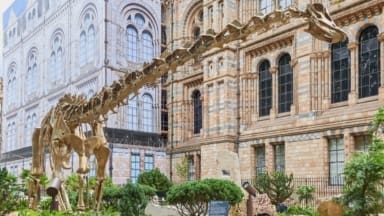
For the first time in 140 years, the gardens wrapping around the Natural History Museum have been completely transformed. Through two new outdoor galleries, complete with new resident dinosaur, the new gardens, fully accessible, provide visitors an immersive, fascinating insight into the incredible story of Earth, stretching back more than 2.7 billion years. A captivating story, cunningly told through an immersive timeline of plants, geology, and representations of reptiles, birds and mammals.
The garden’s evolutionary timeline starts with a canyon clad in ancient stone collected from across the UK. A stunning new bronze cast of the Museum’s much-loved Diplodocus carnegii (named Fern) takes centre stage in the Jurassic garden, planted with Wollemi pines, dwarf ginkgos and cycads to evoke the feel of a landscape in the Jurassic Period. Named by local school children, ‘Fern’ is an incredible, anatomically correct, dynamic, self-supporting, 22m long bronze sculpture, created by Factum Arte in collaboration with the Natural History Museum, Fademesa Foundry in Madrid, and the Structure Workshop in London.
Over in the west garden towards the Museum’s Darwin Centre, visitors will find the Nature Discovery Garden, where different habitats showcase the rich biodiversity that can be found in the UK’s urban spaces, and an accessible sunken pathway winds between a series of ponds.
Designed by architects Feilden Fowles with landscape firm J&L Gibbons, the gardens provide a captivating evolutionary, paleobotanical safari, from the earliest mosses and liverworts, to the emergence of tree ferns and carboniferous forests to the subsequent arrival of flowers, savannahs and woodland. Grass is distinctly absent because that emerged only around 55 million years ago.
Designed with sustainability in mind, the new gardens were created with the landscape and are an example of a sustainable construction, from a diesel-free site, no waste (sent to landfill) and harvesting rainwater for the plants. The Museum’s Wildlife Garden was extended to double the area of native habitats within the grounds and the pond area has been increased by 60%, to better support the animal and plant life diversity.
Dr Doug Gurr, Director of the Natural History Museum, said: “We are incredibly excited for visitors to get lost in nature and the story of our planet, stretching back 2.7 billion years, as they explore our completely transformed gardens this summer. Beneath the graceful gaze of our newest dinosaur Fern, two immersive outdoor galleries are already teeming with wildlife. It’s the perfect place for all to connect with and learn about the nature on our doorsteps. We know that for people and planet to thrive, we must act to support urban nature recovery. As well as a new way for visitors to engage with the Museum, our reimagined gardens will play a vital role in understanding how nature in our towns and cities is responding to a changing planet, and how we can better safeguard it.”
The Museum’s Urban Nature Project is a response to the urgent need to monitor and record changes to UK urban nature and support its recovery. As well as a place for visitors to explore the diversity of life on Earth, the gardens are a living laboratory, and one of the most intensively studied urban nature sites of its kind in the world.
Scientists will observe wildlife and collect eDNA samples from the gardens. A network of 25 scientific sensors will also gather environmental and acoustic data, from underwater recordings in the pond and the buzz of insect wings to bird calls to traffic noise – all to help understand how urban nature is changing and what we can do to support its recovery.

